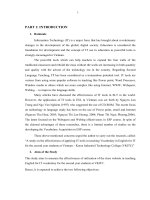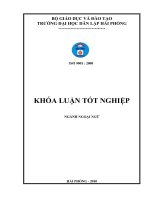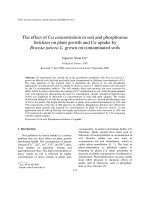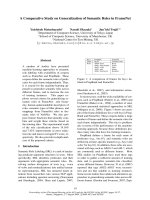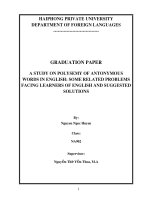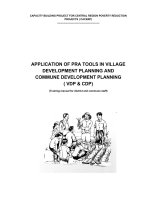Manual on Application of Molecular Tools in Aquaculture and Inland Fisheries Management
Bạn đang xem bản rút gọn của tài liệu. Xem và tải ngay bản đầy đủ của tài liệu tại đây (1.33 MB, 82 trang )
Manual on Application
of Molecular Tools in
Aquaculture and Inland
Fisheries Management
MANUAL ON APPLICATION OF MOLECULAR TOOLS IN AQUACULTURE AND INLAND FISHERIES MANAGEMENT: PART 1 NACA Monograph 1
www.enaca.org
Part 1
Conceptual basis of
population genetic
approaches
Part 1:
Conceptual basis of population genetic
approaches
Contributors
Thuy Nguyen
Network of Aquaculture Centres in Asia-Pacifi c
David Hurwood, Peter Mather
School of Natural Resource Sciences, Queensland University of Technology
Uthairat Na-
Nakorn
Kasetsart University, Thailand
Wongpathom Kamonrat
Department of Fisheries, Thailand
Devin Bartley
Food and Agriculture Organization of the United Nations
Manual on Application of
Molecular Tools in Aquaculture
and Inland Fisheries
Management
Queensland University
of Technology
Brisbane, Australia
© Network of Aquaculture Centres in Asia-Pacifi c
PO Box 1040, Kasetsart University Post Offi ce
Ladyao, Jatujak
Bangkok 10903
Thailand
Email:
Nguyen, T.T.T., Hurwood, D., Mather, P., Na-Nakorn,
N, Kamonrat, W. and Bartley, D. 2006. Manual on
applications of molecular tools in aquaculture and
inland fi sheries management, Part 1: Conceptual basis of
population genetic approaches. NACA Monograph No. 1,
80p.
ISBN 978-974-88246-1-1
Printed by Scandmedia, Bangkok.
NACA MONOGRAPH SERIES
NACA is an intergovernmental organization that
promotes rural development through sustainable
aquaculture. NACA seeks to improve rural income,
increase food production and foreign exchange
earnings and to diversify farm production. The
ultimate benefi ciaries of NACA activities are farmers
and rural communities.
Visit NACA online at www.enaca.org for hundreds
of freely downloadable publications on aquaculture
and aquatic resource management.
3
Contents
Preface 5
Acknowledgements 7
Background 9
Target audiences 11
Aims, scope and format of the manual 12
Abbreviations 13
Section 1. The fundamental nature of DNA 15
1.1 Basic DNA structure 17
1.2 Where does variation in DNA sequences come from? 18
Section 2. Genetic variation in nature 23
Section 3. Basic concepts in population genetics 29
Section 4. Natural selection 35
Section 5. Genetic drift 41
Section 6. Non-random mating and population structure 47
Section 7. Environmental influences on population processes 55
Section 8. Ecological influences on population processes 63
Glossary 69
Bibliography 79
Preface
The mandate of NACA is to support
member governments in their endea-
vours to achieve long-term sustainabi-
lity of inland fi shery resource utilisation
and aquaculture development. In this
regard, NACA plays a major role in
developing human capacity in aspects
in the member countries.
In the current millennium, inland fi she-
ries resource utilisation and aquacul-
ture development have to go hand in
hand with maintaining environmental
integrity and biodiversity. Conserving
biodiversity has become an important
consideration worldwide. Nations that
import aquaculture products, often
stress that the production processes
must not negatively affect natural
biodiversity. Furthermore, conservation
of biodiversity is an integral component
of responsible fi sheries and enshrined
in the FAO Code of Conduct for
Responsible Fisheries. Consequently,
NACA as mandated by its Governing
Council, is embarking on a program
that attempts to sustain genetic
diversity in relation to inland fi sheries
management and aquaculture develop-
ment in the region.
One of the initial steps is to assist
member nations to achieve the above
broad objectives and to develop human
capacity in the current methodologies
used to assess genetic diversity and its
applications to biodiversity issues in
inland fi shery resource utilisation and
aquaculture development. This manual
is produced to facilitate training
processes that NACA will undertake
in the ensuing years to enable the
member nations to achieve the overall
objectives in regard to maintaining
biodiversity in relation to development
of aquatic resources utilisation.
We accept the fact that a number of
text books are available for reference
in this fi eld. Most however, are
expensive for many users and some of
the techniques provided in them are
not always suitable for many of the
molecular laboratories in the region.
This has prompted us to prepare this
manual, which is designed to be less
expensive, more “user friendly” and of
direct relevance to the region.
Acknowledgements
T. T. T. Nguyen would like to thanks Mr. Pedro Bueno, former Director General
of NACA, without whose support the manual could not have become possible.
Encouragement from Prof. Sena De Silva, Deakin University (current Director
General of NACA) is very much appreciated. P. Mather and D. Hurwood would
like to acknowledge the Australian Centre for International Agricultural Research
(ACIAR) for funding support.
It has generally been accepted that
aquaculture can contribute signifi cantly
to narrowing the gap between demand
and supply for aquatic food supplies.
Currently, aquaculture production is
estimated to be 51.4 million tonnes
annually, valued at US$60 billion. More
importantly, developing countries,
particularly in Asia, account for over
85% of current production. It is most
likely that dominance of Asian coun-
tries in aquaculture production will be
maintained into the foreseeable future.
With increasing developments in
aquaculture however, the sector
also has had to face public concern
in regard to environmental effects.
Aquaculture development with no
regard for social and environmental
issues is no longer acceptable to the
public, be it in developed or developing
countries. Aquaculture development
needs increasingly to take into account
environmental impacts. It is in this
regard that maintaining and sustaining
the environment has become para-
mount. Attention to genetic diversity
and biodiversity in aquaculture devel-
opment and aquatic resource manage-
ment are therefore, crucial elements
for sustainable environments.
Introduction of new species/strains can
affect biodiversity via impacts on the
native gene pool. New species/strains
can hybridise with native stocks,
and hence alter the natural genetic
architecture. This may be expressed
as a loss of valuable genetic material
such as locally adapted genes or
gene complexes or homogenisation
of previously structured populations
via fl ooding with exogenous genes.
In Thailand, one example of such
impacts is the outcome of hybridisation
between the Thai walking catfi sh,
Clarias macrocephalus and the African
catfi sh C. gariepinus (Senanan et al.,
2004). While the long-term impact of
this hybridisation is still to be deter-
mined, there has been a general loss of
genetic diversity in the native species.
Similarly, it has been a suggested
that hybrid Clarias are contributing
to the decline of native C. batrachus
in the Mekong Delta (Welcomme
and Vidthayanon, 2003). A parallel
situation appears to be occurring
elsewhere in Viet Nam, but as yet no
genetic analyses have been conducted
(personal observation).
Stock enhancement is a common fi shery
practice in the freshwaters of many
Asian nations, and is considered to be a
means by which fi sh food supplies can
be signifi cantly enhanced (Petr, 1998
De Silva, 2004). Many enhancement
practices, except those in China and
perhaps India, are however dependent
primarily on exotic species, with little
understainding of their effects on
genetic diversity in the native species.
A limited study conducted in Thailand
appears to indicate that stock enhance-
ment together with escapees from
aquaculture operations have brought
Background
10
about a decrease in genetic diversity
in the silver barb Puntius gonionotus
populations (Kamonrat, 1996). Indeed,
the observation itself indicates a need
to step up the number of similar studies
in the region to enable measures to be
adopted that ensure levels of genetic
diversity and biodiversity can be
sustained for the long-term.
The major regional genetic program
initiatives in Asia have thus far largely
been confi ned to selective breeding
programs, a much needed area of
work for aquaculture development in
the region. None of these programs
were directly related however, to
contributing to aquatic resource
diversity. On the other hand, at recent
regional workshops (Gupta and Acosta,
2001) in which most Asian nations were
represented, ongoing and planned
genetic related work was discussed
and some consideration was made
regarding biodiversity and conservation
issues. Unfortunately, there were a very
limited number of biodiversity related
studies reported.
To date only a limited number of
studies have addressed biodiversity
issues in freshwater species in the
region. These studies have raised
however, important concerns regarding
the potential negative impacts of
aquaculture on biodiversity. Of
particular concern is the ongoing
practice of translocations and importa-
tion of exotic strains/species for culture.
Senanan et al. (2004) and Na-Nakorn
et al. (2004) have provided evidence
that African catfi sh (Clarias gariepinus)
genes have introgressed into native C.
macrocephalus of wild and broodstock
populations in Thailand, while
Kamonrat (1996) demonstrated that a
similar situation has resulted for silver
barb Puntius gonionotus.
Another major concern is poor stock
management practices in hatcheries,
especially with respect to broodstock
management, which may lead to losses
of genetic variation in culture stocks
due to genetic drift and inbreeding.
Although the number of published
works on this matter are limited (e.
g. Eknath and Doyle, 1990) there is
anecdotal evidence for genetic erosion
of cultured stocks especially with
regard to the major carp species.
Asian nations in the meeting of the
International Network of Genetics in
Aquaculture in 2000 (Gupta and Acosta,
2001) recognised that more attention
needs to be paid to biodiversity and
conservation issues. Thus while atten-
tion should be paid to genetic improve-
ment of important cultured species,
increasing awareness of the potential
impacts of aquaculture and fi sheries
(and related activities) on biodiversity
is also very important at this stage.
There is a need to build the capacity of
regional fi sheries agencies in molecular
genetic techniques to address this issue.
Genetic diversity studies in the region
should therefore focus on:
Genetic improvement of important
cultured species
•
11
Assisting management practices in
aquaculture operations, especially
broodstock management
Resolving taxonomic uncertainties,
and phylogenetic relationships,
especially for those species or
populations that are endangered
and/or commercially important
Documenting patterns of natural
genetic diversity and identifying
management units
Assessing genetic impacts of
cultured stocks on indigenous stocks
In the light of the major aquaculture
developments taking place in Asia,
urgent attention is needed on biodi-
versity and genetic integrity issues of
cultured as well as indigenous wild
stocks; issues that are increasingly
•
•
•
•
raised by the public and nations that
import aquatic products. It is in this
regard that there is a great need to
build capacity in applied molecular
genetic capabilities at the national
and regional levels. This will allow
characterisation of the genetic
resources of relevant species important
to aquaculture and inland fi sheries
in the respective nations/sub-region.
Knowledge on the applications of
molecular genetics to aquaculture and
fi sheries management will help reduce
the negative impacts of many current
activities on biodiversity, and allow
development of suitable strategies for
maintaining and sustaining diversity. It
will also help to provide a useful guide
to the identifi cation and conservation
of genetic integrity of aquatic species
within the region.
Target audiences
This manual is expected to enable
NACA member country personnel to be
trained to undertake molecular genetic
studies in their own institutions, and
as such is aimed at middle and higher
level technical grades. The manual can
also provide useful teaching material
for specialised advanced level university
courses in the region and postgraduate
students.
The manual has gone through two
development/improvement stages. The
initial material was tested at a regional
workshop and at the second stage
feedback from participants was used to
improve the contents.
12
utilised in population genetics and
systematic studies. In addition, a
brief discussion and explanation of
how these data are managed and
analysed is also included.
Aims, scope and format of the manual
The aim of this manual is to provide a
comprehensive practical tool for the
generation and analysis of genetic data
for subsequent application in aquatic
resources management in relation to
genetic stock identifi cation in inland
fi sheries and aquaculture.
The material only covers general
background on genetics in relation
to aquaculture and fi sheries resource
management, the techniques and
relevant methods of data analysis
that are commonly used to address
questions relating to genetic resource
characterisation and population genetic
analyses. No attempt is made to include
applications of genetic improvement
techniques e.g. selective breeding or
producing genetically modifi ed organ-
isms (GMOs).
The manual includes two ‘stand-alone’
parts:
Part 1 – Conceptual basis of
population genetic approaches:
will provide a basic foundation on
genetics in general, and concepts of
population genetics. Issues on the
choices of molecular markers and
project design are also discussed.
Part 2 – Laboratory protocols,
data management and analysis:
will provide step-by-step protocols
of the most commonly used
molecular genetic techniques
•
•
13
A Adenine
AA Amino Acid
AFLP Amplifi ed fragment length polymorphism
AMOVA Analysis of molecular variance
ANOVA Analysis of variance
C Cytosine
DGGE Denaturing Gradient Gel electrophoresis
DNA Deoxyribonucleic acid
dsDNA Double stranded DNA
G Guanine
GD Genetic drift
HWE Hardy-Weinberg Equilibrium
IBD Isolation-by-distance or identical-by-descent
kb 1000 nucleotide base pairs (kilobase)
LHT Life history traits
MDS Multidimensional scaling ordinations
MHC Major histocompatability complex
mRNA Messenger ribonucleic acid
MSN Minium spanning network
mtDNA Mitochondrial deoxyribonucleic acid
MU Management units
NCA Nested clade analysis
nDNA Nuclear deoxyribonucleic acid
Nm Effective number of migrants (where N= effective population size
and m=mutation rate)
NS Natural selection
PCR Polymerase chain reaction
RAPD Random amplifi ed polymorphic DNA
RE Restriction enzyme
RNA Ribonucleic acid
SCR Semi-conservative replication
SSCP Single strand conformational polymorphism
SSR Simple sequence repeats
T Thymine
TGGE Temperature gradient gel electrophoresis
U Uracil
Abbreviations
The fundamental nature
of DNA
SECTION 1
Traditional approaches in fi sheries for
identifying populations that should be
managed separately (i.e. management
units) have relied on documenting
population life history traits including
reproductive condition both temporally
and spatially, breeding and feeding
sites, population specifi c behaviours,
and movement patterns to infer simi-
larity or independence of gene pools.
While the results often are in accord
with subsequent population genetic
analyses of the same populations this
may not always be the case (i.e. obser-
vations of morphological similarity does
not necessarily mean individuals belong
to the same reproductive unit or
observations of mating do not neces-
sarily imply successful reproductive
input into the population). Molecular
analyses (either direct or indirect) have
the capacity to directly test if morpho-
logical similarity corresponds with
genetic similarity or breeding actually
results in genetic exchange. This is
because a large amount of essentially
ecological and life history information
is retained in the DNA and is expressed
as variation in DNA sequences. So
the basis of using Population Genetic
approaches for identifying manage-
ment units in fi sheries is to understand
the basic attributes of DNA, how it
changes (evolves) and the limitations
on storage of life history information in
DNA sequences.
1.1 Basic DNA structure
DNA is a polymer and a macromolecule.
It consists of three building blocks,
Nitrogenous bases, a Pentose sugar
(Deoxyribose in DNA and Ribose in
RNA) and a Phosphate group. The three
components are bound covalently and
when joined are called a Nucleotide.
There are four kinds of nucleotide
present in any DNA strand. Essentially,
the sugar and phosphate form the
backbone of the molecule and the
backbone is identical in all DNA and
RNA molecules. The only potential
difference between any two DNA or
RNA molecules are the sequences of
nitrogenous bases, so it is this sequence
that encodes the genetic traits in an
organism. There are four bases in both
DNA and RNA: Thymine (T), Guanine
(G), Adenine (A) and Cytosine (C) in
DNA with Uracil (U) replacing (T) in
RNA. For a long time the idea that all
genetic diversity could be explained by
sequence variation in four nucleotides
was disputed because scientists
could not comprehend how the
diversity observable in nature could be
explained by variation in only 4 bases.
This was because biologists already
new that there are 20 common Amino
Acids (AAs) that are the building blocks
of cells present in living organisms and
it was diffi cult to see how four bases
could encode the diversity of amino
acids unless groups of bases were read
together. The discovery of the genetic
code whereby bases are read in groups
of three bases (Codons) and then
decoded into Amino Acids (AAs) solved
this problem.
Other important aspects of DNA (RNA)
structure to consider include; the
Base-Pairing Rule whereby because
of their chemical structure and the
physical structure of the DNA molecule
A binds to T (U) and C binds to G
18
and the fact that the bases in a DNA
molecule are held on the inside of
the helix and joined by a hydrogen
bond. This allows for DNA replication,
a necessary attribute for reproduction
(both cellular and whole organism)
and thus for near faithful transmission
of genetic information from cell to
cell and organism to organism. DNA
replication is Semi-conservative (SCR)
that implies that when DNA replicates
the two strands separate with each
old strand acting as a template for
the production of a new strand that
should have the reciprocal sequence to
the strand that was used to generate
it because replication occurs according
to the base-pair rule (A - T and G – C).
This is important to recognise because
this attribute provides the basis for
later proof-reading of new strands of
DNA whereby the sequence along the
new strand can be proof read by special
enzymes to check to see if the correct
base has been incorporated. Where an
incorrect base has been incorporated in
the new strand and this is detected by
the repair enzyme relative to the old
strand, it can be corrected. If however,
a change occurs in both strands simul-
taneously then repair enzymes have no
reference point to correct the change.
The mechanism of DNA replication
that occurs naturally in all cells forms
the basis of a very powerful technique
that was developed in the late
1970’s/early 1980’s called Polymerase
Chain Reaction (PCR). Essentially, PCR
mimics what happens naturally in the
cell during DNA replication (in vivo) in
a test tube (in vitro). We will discuss this
in more detail later but to demonstrate
the similarity, all of the ingredients
placed into a test tube at the start of a
PCR reaction are basically identical to
what is present in the nucleus of a cell
during DNA replication except we use
an artifi cial short piece of DNA (called
a Primer) to specify the sequence of
DNA we wish to amplify. The other
components are the same; target
chromosomal DNA, a catalytic enzyme
- DNA Polymerase, building blocks of
new DNA strands – free nucleotides and
a buffer to stabilise the reactions. By
cycling the reaction repeatedly, millions
of copies of the target sequence are
generated so we can easily harvest it
from the limited copies of other DNA
sequences. So DNA replication provides
us with a method for producing a
specifi c target DNA sequence from a
mix of all sequences in the cell.
1.2 Where does variation in
DNA sequences come from?
When we compare the same DNA
sequence from two individuals we
may detect a different base at the
identical point along the sequence.
This difference is referred to as a
Mutation or base-pair substitution.
Mutations are the result of ‘rare’
errors during DNA replication but are
a basic requirement for Evolution as
a process of change because without
mutation all DNA sequences would be
identical to the fi rst DNA sequence(s)
that evolved originally. Potential for
accumulating mutational change is an
attribute of DNA and RNA molecules
and is the basis for the differences we
see in living and extinct organisms.
Mutations can occur anywhere in the
DNA (both in coding and non-coding
19
DNA) but where they occur in coding
DNA they may produce changes in the
AA sequence and be expressed as new
phenotypes. If the mutation is present
in some individuals in the population
and not in others then the differential
expression of the two phenotypes in a
particular environment allows the envi-
ronment to select the most appropriate
form. The effect may be to change the
relative frequency of the two different
forms of the gene in the population
over time. Mutation rates vary widely
among DNA sequences in an organism’s
genome and relative mutation rate to
a large extent is determined by what
role (if any) a particular DNA sequence
serves in the organism. So, the more
important the role of an individual
sequence is to the individual, the more
slowly the sequence is likely to accumu-
late mutations and therefore evolve.
There are a number of different ways in
which DNA can be modifi ed by muta-
tions, from simple base-pair substitu-
tions involving individual nucleotides
to changes in whole blocks of DNA,
to loss or gain of a sequence or larger
changes that could include loss or gain
of one or more individual chromosomes
or even whole chromosome sets
(polyploidy). When they occur, their
probability of long-term incorporation
(survival) depends on their impact on
Gene function. Non-coding DNA will
tend to accumulate more mutations
and so evolve faster than coding DNA
because mutations in this type of DNA
do not directly affect gene function.
As a general rule, the more important
the gene function, the lower the rate
of mutation. The types of mutations
most relevant to analyses of population
structure are point substitutions e.g.
GAG to GUG and deletions or insertions
(Indels) of bases in a sequence e.g. GAG
to GAGG.
Effects that mutations can have vary
widely from no effect on the individual
to death and there are no simple rules
that we can apply to say what the
likely impact of a particular type of
mutation is going to be. The impact
is determined by where they occur in
the genome and what changes they
produce. The simple fact is however
that because mutations are random,
when they occur in coding sequences
they are likely to be deleterious (i.e.
produce poor outcomes), simply
because they are random changes to
DNA. Ultimately the environment is
the key however, as to whether a new
mutation in coding DNA will provide
better or poorer phenotypes.
Until the development of molecular
technologies for examining vari-
ation in natural populations, the
most common characters used to
document variation were studies of
external morphological phenotypes
and while mutations in genes that
code for morphological phenotypes
can produce different outcomes,
often these mutations do not survive
because there can be strong functional
constraints on many morphological
traits. Thus morphological evolution
can be a relatively slow process and
populations may diverge genetically
without any changes appearing in
their external morphology. Many
morphological traits are also polygenic,
20
meaning that they are the product of
the combined effect of a few or more
commonly many gene loci that may
be expressed differently in different
environments. This means that many
systematic or population variation
studies based solely on examination
of variation in external morphological
traits may underestimate the real
extent of underlying genetic variation
and hence population structure. Simply
put, population studies based simply on
morphology are unlikely to detect all of
the signifi cant population structuring
that may exist in a species. Molecular
systematic studies in contrast, are not
limited in the same way.
Molecular markers can provide a more
fundamental data set than morphology
for examining relationships among
populations and higher taxonomic
levels. One important difference is
that they are not complicated by any
potential effect of the environment
because they are fi xed at fertilisation.
If we target areas of DNA that do not
encode phenotypes (i.e. non-coding
DNA), these markers are usually
neutral in respect to potential effects
of Natural Selection (NS). Thus they
should accumulate mutations at a
constant rate determined by their
locus specifi c mutation rates. What this
means effectively is that the absolute
number of mutations between homolo-
gous sequences in two individuals
provides an absolute estimate of the
time since they shared a common
ancestor after allowing for the locus
specifi c mutation rate. Where DNA
sequences evolve neutrally, they allow
phylogenetic relationships between
individuals, populations, species etc.
to be constructed without the need to
consider complications of factors like
transient impacts of natural selection
or environmental effects on sequence
divergence. Thus neutral markers can
provide more fundamental information
about phylogenetic relationships than
can studies of morphology alone.
But molecular markers like morpho-
logical markers can also have associated
problems that we need to address if we
are going to use them constructively.
For example, protein-based markers
such as allozymes, often show low
levels of polymorphism hence they may
not be suitable for detecting genetic
differentiation of organisms having
weak population structure such as
many marine organisms. Also, allozyme
studies only detect a portion of the
actual genetic variation because not
all nucleotide changes lead to amino
acid changes and not all amino acid
substitutions result in electrophoreti-
cally detectable mobility differences.
A major problem with DNA markers
can be Homoplasy. Since there are only
four potential character states at any
point along a DNA sequence (A, T, C or
G), eventually by chance mutations can
change a single base many times, but
we are only able to determine the base
that is present at a particular location
when we sequence that region (i.e.
now), not what may have been there in
the past. If we compare two individuals
and fi nd that they both share the same
base at a particular point along a DNA
sequence we interpret this as similarity
due to common descent. If however,
they share the same base due to
21
homoplasy we have no way of knowing
this. Thus, it is essential to choose DNA
markers carefully. Appropriate DNA
markers need to evolve fast enough
so that populations or species show
differences, because without variation
there is no basis for phylogenetic infer-
ence, but they must also evolve slowly
enough so that there is little chance
of character convergence (homoplasy)
where we will score similarity, incor-
rectly. For any DNA marker there will
be a point reached when homoplasy
will become an issue, so we should
choose a DNA marker appropriate for
the time frame we are examining to
reduce possible confounding effects of
homoplasy. This point theoretically, is
when suffi cient evolutionary time has
elapsed, given the mutation rate at the
locus, for all four character states to
have been expressed (A, T, C and G) at
a single point with the fi nal outcome
being a return to a character state
that previously occurred there. When
this point is reached, we are likely to
underestimate the real divergence time
between two individuals with the same
genotype.
The recognition that DNA sequences
evolve at a constant rate as a function
of their locus specifi c mutation rates,
implies that the same gene sequence in
two populations should evolve at the
same rate. This is the basis for the idea
of the ‘Molecular Clock’. Essentially,
what this means is that assuming
population sizes are similar and remain
constant over time, individuals in
different populations will accumulate
mutations at approximately the same
rate and so the absolute minimum
number of mutations between any
two individuals in each population can
be used to calculate the evolutionary
time that has elapsed since they last
shared a common ancestor, once we
have calibrated for mutation rate. Put
another way, the absolute number of
mutational differences between the
two individuals with the most similar
genotypes in each population is a
direct refl ection of how closely related
the two forms are. Once we have this
information we can correlate estimated
divergence times with past earth
geological or climate history events
that may have impacted on the evolu-
tion of the different forms.
An example of this is the evolution
of the fl ightless ratite birds (Emus,
Ostriches, Rheas, etc.). Ratites are an
ancient order of birds that now are
limited to a few relict species confi ned
to the southern continents (Australia,
Africa and South America, respectively).
Molecular analyses confi rm both
the relationship between the three
surviving families and the fact that
they last shared a common ancestor
in the Cretaceous. The simplest
explanation for their evolution is that
the common ancestor evolved when
the three continents were part of a
super continent (Gondwana) that also
included Antarctica. This giant land
mass that was fractured subsequently
due to tectonic plate movement that
lead to the sequential rafting of the
three continents northward carrying
their ancestral fl ightless ratites with
them (fi rst Africa, then South America
and fi nally Australasia). The relatives
of the ancient ratites (Emus, Ostriches
22
and Rheas etc.) are now living evidence
for both the existence of giant super
continents in the past but also for how
Molecular Systematics can help to tease
out the processes that have infl uenced
modern biodiversity. Vicariance due to
the splitting of the Gondwanan land
mass has also been invoked to partially
explain the distribution of freshwater
galaxids among southern hemisphere
continents (Waters et al., 2000).
Genetic variation in nature
SECTION 2
